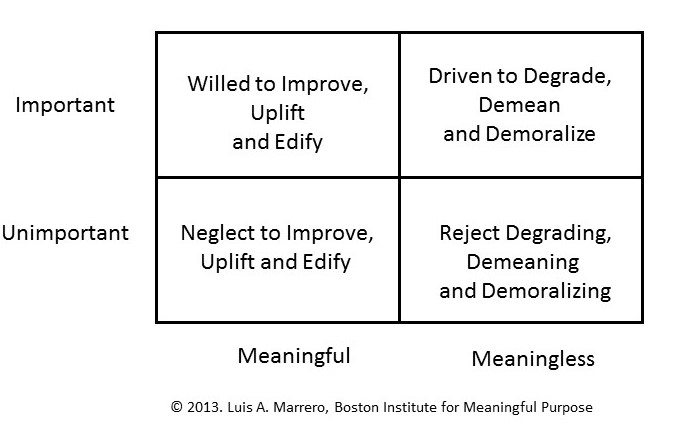Submitted by Luis A. Marrero, M.A., RODP, LLP, Boston Institute for Meaningful Purpose, for the Positive Living Newsletter (July 2017). Read the rest of the newsletter here.
It is not a secret that defining and differentiating meaning and purpose continues to be a challenge for researchers and practitioners alike. This became apparent to me in the course of reviewing the literature while writing my book, The Path to a Meaningful Purpose: Psychological Foundations of Logoteleology. And since publishing the book back in 2013, the debate continues.
Being a practitioner, and being intimately aware that my corporate clients demand clear definitions, I pressed on to define the terms following a reasonable discovery process and studying respected sources. Yet, I wrote the following in the preface of my book:
I must also state that my approach through this book is not to disprove and challenge others’ theories as wrong; rather, my goal and resolve is to offer a framework that is valuable, relevant, and meaningful.
Simply stated, I doubt my infallibility, and do not believe that my theory and definitions are above anyone else’s. My goal has been and continues to be to solve real life problems using sound theory and practical methods. Such a goal requires clear definitions, and I was ready to take a stand for the sake of my clients.
Meaning, Meaningful and Important
Hereafter I will use meaningful purpose psychology (MPP) and its scientific name, logoteleology, interchangeably.
In the logoteleology method, meaning, meaningful, and important are not synonymous. To the question, “What is meaning?” Viktor Frankl (1998) provided a simple and practical answer: “Meaning is what is meant, be it by a person who asks me a question, or by a situation which, too, implies a question and calls for an answer” (p. 62) and “there is only one meaning to each situation, and this is its true meaning” (p. 60). Here are two additional and complimentary definitions from the Merriam-Webster Dictionary:
- the idea that a person wants to express by using words, signs, etc.
- something meant or intended
Pertaining to what a person wants to express, British analytical psychologist Dale Mathers (2001) summarized well what the combined intended meaning and the decoded meaning denote: “Meaning is an act of communication, rather than a communication” (p. 3). Here, communication is a two-way exchange that succeeds when both parties are “on the same page” or when understanding is shared and mutual. Hence, there is a shared meaning.
The second, meaning as “something meant or intended” is about conveying intentions or aims. This intentional effort is stronger than casual everyday exchange of information. Here is how the dictionary defines “meant”:
- to have in mind as a purpose: intend
- to serve or intend to convey, show, or indicate: signify
- to have importance to the degree of
- to direct to a particular individual
- to have an intended purpose
- Something that is conveyed or intended, especially by language, sense of significance
- Full of meaning, expressive.
In MPP, we use these definitions of “meaning” or “to mean” to explain how individuals intend, convey and grant significance and value.
For a more in-depth explanation, please refer to the article in my blog, Meaning, Meaningful and Important: The Powerful Three.
What is Meaningful and Meaningless?
In MPP theory and method, the meaningful builds, enhances, and points to what is significant and beneficial. Acting in a meaningful way intends to honor, respect, exalt, validate, and value something and someone. For instance, you probably believe that your country’s flag is meaningful because of what it represents—the kinship with fellow citizens, the country’s history, its language, culture, and traditions—all which have a special significance in the flag’s colors. You would also agree that, for some individuals, serving and doing good to others is meaningful. This is consistent with psychological literature where meaningfulness is defined “as a generally positive or beneficial outcome for individuals and organizations” (Berg, Dutton & Wrzesniewski, 2013, p. 82). In contrast, the meaningless is something or someone we could consider useless, trivial, worthless, insignificant, as well as having low value. For many of us it is not difficult to discern what is and is not meaningful behavior.
Hence, meanings can be meaningful or meaningless.
What is Important and Unimportant?
In MPP theory, “important” does not equate “meaningful.” Nor does “unimportant” parallel “meaningless.” In MPP, a person can give importance to the meaningless, as has been defined in this article.

Figure 1. Meaningful / Important Quadrant
Figure 1 presents four behavioral options individuals and institutions can follow and apply.
- The important and meaningful displays behavior intended to edify and improve.For instance, I can choose to recognize a peer for a job well done.
- The unimportant and meaningless indicate behavior that avoids demeaning others. As an example, I decide not to infer that my theory and method is better than others’ approaches.
- The important and meaningless bears out behavior intended to demean and degrade people. As in the case of a bully in a school yard who verbally and physical abuses others.
- The unimportant and meaningful reveals behavior that neglects to build and edify others.As when a person chooses to neglect recognizing another for her or his good performance.
Based on these explanations, options one and two are more acceptable and worthwhile. Options three and four should be avoided at all cost.
What is Purpose?
In the MPP method, purpose fulfills meanings. Let me provide a simple example of meaning and purpose in action through an individual’s professional meaningful purpose (Marrero, 2013, p. 164).
I publish children’s books in order to promote the love of learning.
In the MPP method, a meaningful purpose must answer three questions, the first related to the purpose, the second to the beneficiaries, and the third to the meaning.
| Purpose | What do you do? | I publish and promote |
| Beneficiaries | For whom? Who benefits? | Children |
| Meaning | How do the children benefit? | Through the love of learning |
Hence, the intended meaning is to encourage the love of learning. The meaning is fulfilled through the purposeful actions of publishing and promotion.
Here is an example from the corporate world.
The on-time airline of the business traveler.
| Purpose | What do you do? | We provide air travel service |
| Beneficiaries | For whom? Who benefits? | The business traveler |
| Meaning | How do business travelers benefit? | We get to the destination on time |
As you can see from the previous examples, the role of purpose it to fulfill a meaning. Notice that purpose entails the use of verbs. In our method, meanings provide the why, while purpose provides the what and how.
Thanks to the Greeks
To overcome the tendency of treating meaning and purpose interchangeably as if they are the same, I went to the Greek dictionary and concordance to help me differentiate between both. Here is what I found.
| LOGOS (MEANING)
λόγος |
TELOS (PURPOSE)
τέλος |
| Reason | Consummation |
| Cause | Closure |
| Ground | Results |
| A thought | Reaching end/aim |
| Expectation | Purpose |
Hence, in our method, as previously explained, meaning (logos) is how something or someone is defined, as well as an intention or reason for doing something; while purpose (telos) is the fulfillment or consummation of the meaning. One intends, the other accomplishes.
Why Does Differentiating Matter?
Differentiating and clearly defining meaning, meaningful, meaningless, important, unimportant, and purpose—as defined in this article—allows logoteleologists to aid clients with confidence and certainty. Clients also find the definitions practical and can quickly discern what their current behavior says about their meanings. To be more specific, clients can quickly determine if their meanings are meaningful or meaningless, and what has prominence or importance in their lives or style of leadership. For instance, guided by a qualified logoteleologist, they can answer the sample questions, “I have been living my life as if what is its meaning?” and “I have been leading my organization as if what is the meaning of my leadership?”
Using the Meaning / Important Quadrant, and understanding the consequence of each of the four options, the client is encouraged to take responsibility (self-determination) for her or his life, and to choose which path to follow. If the client selects to give importance to the meaningful, she or he is encouraged to commit to a meaningful life purpose consistent with her or his choice and strengths.
For more information on how to leverage these definitions for coaching, therapy, counseling, and Organization Development consulting, please contact the author (luis@bostonimp.com). Comments and questions are also encouraged.
References
- Berg, J. M., Dutton, J. E., & Wrzesniewski, A. (2013). Job crafting and meaningful work. In B. J. Dik, Z. S. Byrne, & M. F. Steger (Eds.), Purpose and meaning in the workplace (pp. 81-104). Washington, DC: American Psychological Association.
- Frankl, V. E. (1998). The will to meaning: Foundations and applications of logotherapy. New York, NY: Meridian.
- Marrero, L. A. (2013). The path to a meaningful purpose: Psychological foundations of logoteology. Bloomington, IN: IUniverse.
- Mathers, D. (2001). Meaning and purpose in analytical psychology. Philadelphia, PA: Taylor & Francis.

 Meaning Conference 2025 will be the INPM’s first in-person conference with a virtual option after the pandemic.
Meaning Conference 2025 will be the INPM’s first in-person conference with a virtual option after the pandemic.